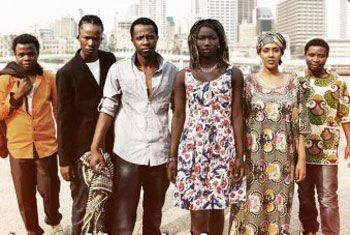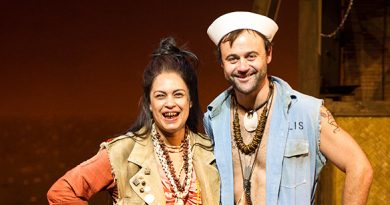I Am Here

Something terrifying happened recently in Brisbane; a group of refugees took over the Bille Brown Studio on Montague Road and gave the audience an experience that they would never forget; a gutsy and moving account of their lives so far. I Am Here is a work of real stories devised by Two Thumbs Up and presented by Queensland Theatre Company (QTC) and the Multicultural Development Association (MDA).
Future D Fidel, Pacific Hagenimana, Eric Kagorora, Levi Lako, Concy Layet and Senayt Mebrahtu callAustraliahome but not so very long ago they were all children of war, fleeing homes broken by the ravages of civil conflict. Some of them, by age eight had watched their families murdered and then travelled alone across several East African countries to find refuge. They have since become young adults with dreams and aspirations and they have since become teachers, benevolent and patient.
I Am Here reimagines the harrowing stories of these young people into three narratives that present a universal insight into children caught up in the chaos of conflict. The work is achingly honest and heartbreaking; powerful enough to reduce the stiffest upper lip to a quiver yet somehow moments of innocence and humour are found between situations that seemingly kill all joy forever.
The professional control of the performers during acts of violent loss, such as when Future D Fidel pleads to his dying Mother to hang on, was remarkable and they had the ability to capture the spirit of the child they once were through the way they held their bodies and held onto each other. It seemed, in a way to be almost reverse acting; rather than trying to imagine themselves in that space and create character, they had to remain controlled enough to take us all back with them and peer over the edge of the drama without falling into the void.
The story began by briefly introducing the children in peace, playing as all children everywhere do and taking delight in teasing each other. It was a perfect humanising moment, a reminder that refugee is just another word for human being, albeit a human being with some serious scars. The children gather at the feet of their story telling Grandfather and are told a wise old tale about man’s inability to be satisfied. The plight of all men, for better or for worse, can so easily be described by one small fable. Out of the ear-shot of her children, Mother quietly discusses the burgeoning conflict with her father. She plans to flee toSudanand will send for the children when she finds a safe haven. This discussion sets the tone for all the journeys made as the people who are burdened by these different conflicts suddenly find themselves displaced and on the move for self preservation.
Three distinct stories are woven through each other to visualise the pivotal moments that suddenly changed the lives of the children; the horrific Rwandan massacre (fervent chanting soldiers with those machetes are eerie and frightening), the collapse of the Democratic Republic of Congo, life in the Ugandan Kiradongo refugee camp where children are born and live their whole lives and an exodus from war torn Ethiopia. It seems an odd thing to say but there was no gratuitous violence in this production; that is the difference between a story about survival and a story about violence – we didn’t dwell long on the horrors and swiftly found ourselves crossing our fingers at the chance for a new life outside ofAfrica. The interview process for refugees to enterAustraliawas a confronting scene; it seemed a torture unto itself. I had to remind myself that these were just children being asked these awful questions and the desire to slap Director, Andrew Davis in the role of interviewer was strong. This scene then gives way to the entertaining reflection of how the different groups attempt to settle into their new home and make it their own – it seems a lot of dance groups are organised!
After a grand finale of traditional dancing, the audience was both shell shocked and inspired. I don’t think anyone expected a production of this calibre, the story was strong and hard-hitting; they took you to the brink of tears but left you feeling uplifted and hopeful and thoroughly entertained (Eric and Senayt elicited much laughter as they played up a Mother meeting her daughter’s love interest).
Special mention needs to be made of the evening that surrounded the performance. The atmosphere was welcoming, the African community and supporting communities in attendance look you straight in the eye and smile at you as they greet you – it’s warming and astonishing, unlike anything I’ve experienced before. As an outsider you are reminded how gracious a welcome to a new community can be.
After the show, a feast of tasty things from each of the different countries awaited us. Producers Naomi Steinborner and Andrew Davies were a pleasure to hear as they spoke of the journey they made with the actors to create the show. I was so pleased to hear them direct all attention to the remarkable performers rather than talk of their own involvement – they were humble and respectful.
Wesley Enoch in his role as Artistic Director of the Queensland Theatre Company has said that he is actively encouraging diversity in storytelling and Enoch and all that supported this project should be commended. I Am Here is a beautiful and generous gift and it should be required viewing for all. The message is clear, we as humans all have the power and potential to move on from our past identities be that refugee, oppressor, enemy or friend. We are all here and so much more than the sum of our past.

